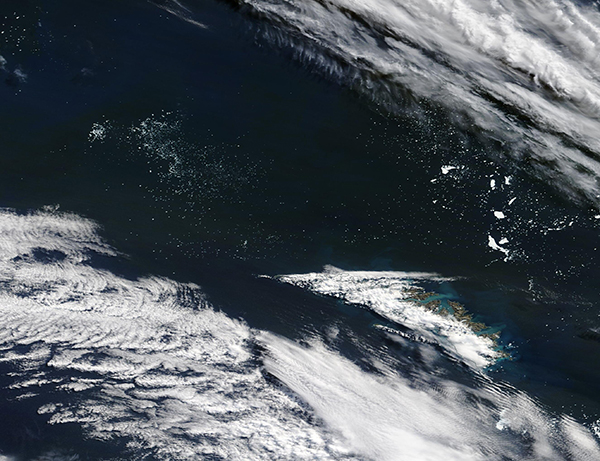Images
March 16, 2021 - Bits and pieces of Iceberg A68 around South Georgia Island
Tweet
On March 12, 2021, the Moderate Resolution Imaging Spectroradiometer (MODIS) on board NASA’s Terra satellite acquired a true-color image of South Georgia Island surrounded by several melting icebergs—including many bits and pieces of that once were part of one of the largest icebergs on record. South Georgia Island can be seen in the lower right quadrant of the image, with parts of what was Iceberg A68A floating both to the north and to the southeast of the island. Other icebergs and smaller bits of ice also are seen, especially northwest of South Georgia. A few clouds cloak parts of the island and sweep across the ocean both in the north and the south of the image.
Almost four years ago, the remarkably massive Iceberg A-68 broke free from Antarctica’s Larsen C Ice Shelf. With a surface area of about 5,800 square kilometers (2,239 square miles), the massive slab of ice was larger than the state of Delaware as well as one of the largest icebergs on record. When it calved, it reduced the total size of the Larsen C Ice Shelf by roughly twelve percent.
Once calved, icebergs will eventually break apart as they drift towards warmer waters and are buffeted by winds and currents. A68 broke into two pieces just a few weeks after calving, but those pieces had held together for most of the last three-plus years, and they were slowly carried by currents in the direction of South Georgia Island. By December 2020, Iceberg A68A (the largest piece of the original ‘berg) was making a close approach to South Georgia Island—so close that scientists were concerned the giant block of ice might pose a threat to penguin colonies and the krill population, should it run aground close to the island. Caught by strong currents, lengthening daylight, and warming waters, A68A made a close pass by the island and began to break up.
On February 10, the U.S. National Ice Center confirmed that a new fracture had given rise to A68P—the 16th fragment of A68 large enough to earn its own name. Additional smaller fragments exist but are not named. According to the National Oceanic and Atmospheric Administration (NOAA), to be classified as an iceberg, the height of the ice must be greater than 16 feet above sea level and the thickness must be 98-164 feet and the ice must cover an area of at least 5,382 square feet. Smaller pieces may be called “bergy bits” (medium to large ice fragment) and “growlers”. Growlers are smaller fragments and are roughly the size of a truck or piano.
Image Facts
Satellite:
Terra
Date Acquired: 3/12/2021
Resolutions:
1km (317.4 KB), 500m (831.2 KB), 250m (586.6 KB)
Bands Used: 1,4,3
Image Credit:
MODIS Land Rapid Response Team, NASA GSFC
Tweet
On March 12, 2021, the Moderate Resolution Imaging Spectroradiometer (MODIS) on board NASA’s Terra satellite acquired a true-color image of South Georgia Island surrounded by several melting icebergs—including many bits and pieces of that once were part of one of the largest icebergs on record. South Georgia Island can be seen in the lower right quadrant of the image, with parts of what was Iceberg A68A floating both to the north and to the southeast of the island. Other icebergs and smaller bits of ice also are seen, especially northwest of South Georgia. A few clouds cloak parts of the island and sweep across the ocean both in the north and the south of the image.
Almost four years ago, the remarkably massive Iceberg A-68 broke free from Antarctica’s Larsen C Ice Shelf. With a surface area of about 5,800 square kilometers (2,239 square miles), the massive slab of ice was larger than the state of Delaware as well as one of the largest icebergs on record. When it calved, it reduced the total size of the Larsen C Ice Shelf by roughly twelve percent.
Once calved, icebergs will eventually break apart as they drift towards warmer waters and are buffeted by winds and currents. A68 broke into two pieces just a few weeks after calving, but those pieces had held together for most of the last three-plus years, and they were slowly carried by currents in the direction of South Georgia Island. By December 2020, Iceberg A68A (the largest piece of the original ‘berg) was making a close approach to South Georgia Island—so close that scientists were concerned the giant block of ice might pose a threat to penguin colonies and the krill population, should it run aground close to the island. Caught by strong currents, lengthening daylight, and warming waters, A68A made a close pass by the island and began to break up.
On February 10, the U.S. National Ice Center confirmed that a new fracture had given rise to A68P—the 16th fragment of A68 large enough to earn its own name. Additional smaller fragments exist but are not named. According to the National Oceanic and Atmospheric Administration (NOAA), to be classified as an iceberg, the height of the ice must be greater than 16 feet above sea level and the thickness must be 98-164 feet and the ice must cover an area of at least 5,382 square feet. Smaller pieces may be called “bergy bits” (medium to large ice fragment) and “growlers”. Growlers are smaller fragments and are roughly the size of a truck or piano.
Image Facts
Satellite:
Terra
Date Acquired: 3/12/2021
Resolutions:
1km (317.4 KB), 500m (831.2 KB), 250m (586.6 KB)
Bands Used: 1,4,3
Image Credit:
MODIS Land Rapid Response Team, NASA GSFC




